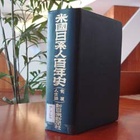Washington State is home to the cities of Seattle and Tacoma, which became the gateway for immigrants when sea routes opened from Japan. Naturally, the history of Japanese and Japanese-Americans there is long.
"The Centennial History of Japanese Americans in the United States" devotes 42 pages to introducing Japanese Americans in Washington State. It begins with an overview, followed by a section titled "The Path of Japanese Development," which explains the history of Japanese activities that began in Washington State.
Next, the first section, "The Condition of the Japanese before the War," explains the situation in terms of industry, education, organizations, anti-Japanese issues, etc. It also touches on the activities of Japanese people scattered throughout the state, including Seattle and Tacoma.
Below, I would like to summarize some of the points that I found interesting.
Regular flights from Japan to Seattle and Tacoma
In the 1880 U.S. census, there were 105,465 Chinese in the United States, but only 150 Japanese, 86 in California, and just one in Washington state.
However, the Chinese were driven out by the Chinese Exclusion Act of 1882. There were also cases where Chinese people in the state were brought to Seattle and then expelled to China by ship. On the other hand, the Japanese were welcomed with kindness and were able to work in various jobs.
On August 31, 1896, Nippon Yusen opened a route to Seattle, and in 1909 Osaka Shosen opened a route to Tacoma, from which the number of Japanese immigrants began to increase.
Japanese workers in Washington State first worked on railroad construction, in lumber mills, and as domestic laborers, but later moved to farms, lumbering, and salmon canning. Their businesses began in restaurants and groceries, and after 1900 they mostly worked in barbershops, laundries, restaurants, and hotels.
Agriculture developed as farmers shifted from farm labor to rented land farming, but was heavily affected by the enactment of the "Foreign Land Ownership and Tenancy Restriction Act" in Washington State in 1921. Dairy farming in particular was wiped out, with no one engaged in the business even after the war. However, agricultural management itself gradually began to own land after the war and built a foundation.
According to the census, the Japanese population in Washington state was 3,617 in 1900, 17,873 in 1930, and dropped to 9,694 in 1950, but recovered to 16,652 in 1960.
Researching Japanese people by specific occupations
"The Condition of the Japanese before the War" gives occupational and demographic statistics for Japanese people living in the central city of Seattle. The 1935 survey lists dozens of occupations and the number of people engaged in each occupation. The Centennial History has similar information about Japanese people in other states. It is easy to imagine that detailed surveys were conducted.
Some of these are unique:
"1 burlap sack merchant," "1 motion picture technician," "3 milk merchants," "2 judo teachers," "6 midwives," "2 bookstores," "20 newspaper reporters," "2 soba shops," "3 fishing tackle shops," "3 tofu manufacturers," "1 wood framer," "60 glove factory girls," and "2 koji makers."
This is only a small part of the total, and it is divided into various occupations related to food, clothing, and shelter that Japanese people need to live. It shows that the Japanese lifestyle has been brought over as is and a large community has been formed. The total number of people is 2,877.
Naturally, schools for Japanese students were also established. A Japanese language school was established in Seattle in 1902, and five years later in Tacoma, with further schools established in various locations. By 1940, the number of Japanese language schools established by Japanese residents in Washington State had reached 21.
Newspapers and other Japanese publications were also widely published. Daily Japanese-language newspapers included North American Current Affairs and Daihoku Nippo. Weekly newspapers included Taishu and Japanese American Korea (in English), and the monthly Nichibei Koron. For many years, Japanese-language newspapers were only in Japanese, but as the second generation grew and their numbers increased, they began to publish English-language pages as well.
Strong anti-Japanese sentiment
In the prewar situation, the book summarizes the hostile movements against the Japanese as "the transition of anti-Japanese sentiment in China." While acknowledging that persecution from white society was not limited to the Japanese, the Centennial History is harshly critical.
In Seattle, the exclusion of workers was most severe against Japanese workers in the sawmills. This spread to other areas.
"The exclusion of workers affected all areas, and those working in the same businesses as Japanese people began to exclude their Japanese competitors. As agriculture, Western restaurants, laundries, hotels, groceries, barber shops, and other businesses developed significantly, a movement to exclude American businesspeople arose. In 1920, the city of Seattle issued a city ordinance to crack down brutally and strict on hotels, secondhand goods stores, baseball stadiums, and markets, and in 1921 the state enacted the Japanese Exclusion Land Act to exclude Japanese farmers."
Regarding the pre-war period, the book touches on Seattle, Tacoma, and the state's "Fife County," "Sumner County," and "Auburn County."
(Note: I have used the original text as much as possible, but have made some edits. In addition, I have based the names of places on the way they are written in the "Centenary History.")
*The next issue will be " Japanese Americans in Washington State – Part 2. "
© 2015 Ryusuke Kawai







